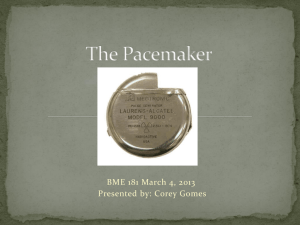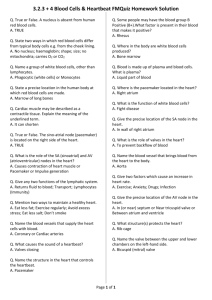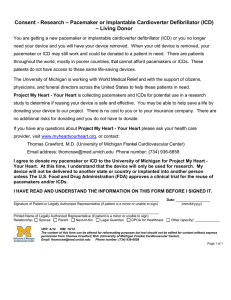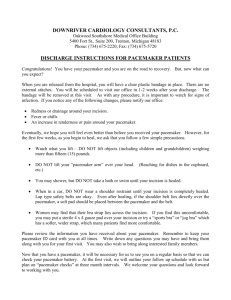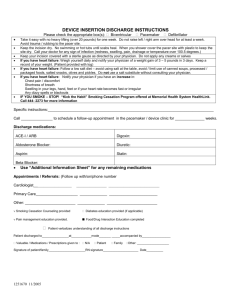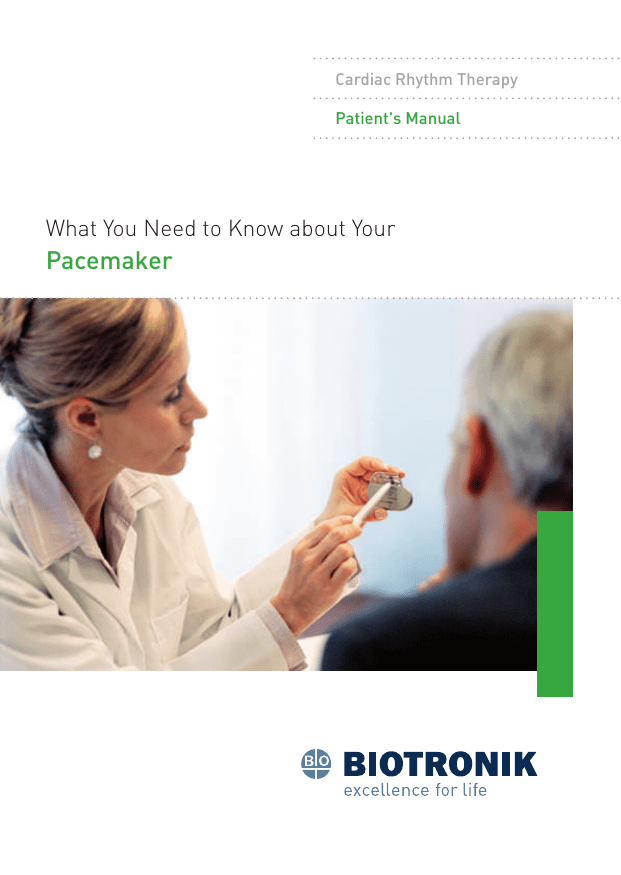
Cardiac Rhythm Therapy
Patient's Manual
What You Need to Know about Your
Pacemaker
What You
Need to Know
about Your
Pacemaker
www.biotronik.com
Contents
Introduction
5
The Heart and Malfunctions of the Heart
6
The Pacemaker
13
The Implantation
21
After the Implantation
22
Living with a Pacemaker
25
Returning to a Normal Life
26
Electric Devices
28
Traveling
32
The Doctor's Visit
33
Answers to Frequently Asked Questions
35
The BIOTRONIK Group
41
Medical Terms
42
Notes
46
Introduction
You are now among the more than two million
people in the world who have a pacemaker.
In the past, a pacemaker's only purpose was to
save lives. Today, patients gain a new quality of life.
Many of them are able to work in their profession
again, to manage their household, to travel, and to
engage in athletic exercises.
In other words: These people again live the life
they were used to. This manual provides you with
useful information about the heart and pacemakers. Your primary physician or cardiac specialist
will be glad to answer any additional questions
that you might have.
BIOTRONIK® – highest quality, technological
progress, reliable pacemakers for more than 40
years.
4|5
The Heart and Malfunctions
of the Heart
The heart is a fist-sized hollow muscle consisting
of four chambers. The two atrial chambers (atria)
form the upper half of the heart, the two main
chambers (ventricles) the lower half. A wall (septum) divides the heart into a right and a left side.
The heart muscle pumps blood through the body
by contracting and expanding regularly. This ensures a sufficient supply of oxygen and nutrients to
various tissues and organs of the body. To gather
the blood and pump it into the circulation systems,
the heart must be stimulated by small intrinsic
electric pulses, which move from the upper to the
lower chamber. In a healthy heart, the sinus node
generates these pulses. Therefore it is also called
the natural pacemaker of the heart. The sinus
node causes the contraction of the heart chambers
and thus supplies a regular, rhythmic heartbeat.
Each pulse of the sinus node triggers a contraction
in the atria. From there, the blood is pumped into
the ventricles.
Lung
Body
Oxygen-enriched blood
Oxygen-depleted blood
A healthy heart in the center of the bloodstream
6|7
Via the cardiac conduction system, the electric
pulse travels through cardiac tissue to cause the
chambers to contract and pump the blood into the
circulatory system.
A healthy heart beats between 60 and 80 times per
minute, equivalent to about 100,000 heartbeats
each day. During physical exercise or under emotional stress, the body needs more oxygen. To respond to these changed conditions, the heartbeat
can increase to more than 100 beats per minute.
Malfunctions of the heart can be traced to a
number of causes.
For example, cardiac disease or the aging process can interfere with the heart‘s natural rhythm.
Malfunctions in the cardiac conduction system up
to its complete blockade are very common.
Sinus node
AV node
Bundle of His
Purkinje fibers
The cardiac conduction system of the heart
The consequence of these pathological phenomena can be an irregular or slowed heartbeat.
In such cases, the body is – especially under
physical stress – not supplied with enough oxygen,
which can lead to dizziness, fatigue, or faintness.
The medical term for these kinds of rhythm disturbances is bradycardia.
8|9
Two common bradycardic arrhythmias are the sick
sinus syndrome and AV block. With sick sinus syndrome, the function of the sinus node is disturbed;
electric pulses are generated irregularly or too
slowly. Especially under stress, the heart is then
no longer capable of adjusting the heart rate to the
increased demands.
With AV block, the conduction of the electric signals of the sinus node through the AV node into the
ventricles is disturbed. If the conduction between
atrium and ventricle is completely interrupted, we
speak of a total AV block. In response, additional
electric centers in the heart usually generate a
very slow auxiliary rhythm to support vital functions.
In such cases, the heart function can be meaningfully supported or supplemented by a pacemaker.
With the help of a pacemaker system, carefully
calibrated electric pulses stimulate the heart muscle
in such a manner that the heart rhythm is once again
similar to that of a healthy heart.
10 | 11
The Pacemaker
Modern pacemaker systems can be adapted to
any specific malfunction of the heart. They consist
of the pacemaker and the leads connected to it.
The pacemaker contains miniaturized electronic
circuitry and a battery. It becomes active whenever
the patient exhibits a disturbed heart rhythm.
For this to happen, the system must be able to
detect the heart's intrinsic activity. When the pacemaker sends an electric pulse, the heart muscle
contracts. The connection between pacemaker and
heart is established by one or two leads. A lead is a
very thin, electrically insulated wire that is anchored in the right atrium or the right ventricle.
12 | 13
Transparent connection head part (header)
Especially
long-lasting battery
Electronic circuitry
Biocompatible titanium housing
The pacemaker
The leads detect the cardiac activity, transmit this
information to the pacemaker, and send the electric pulse to the heart.
Depending on the therapeutic requirements,
single-chamber or dual-chamber pacemakers can
be implanted. The terms relate to the pacemaker's
feature of pacing and sensing intrinsic activities in
The single-chamber pacemaker
either one or both chambers. In a dual-chamber
system, one lead is usually positioned in the
atrium, and another one in the ventricle. Thus, the
activities of the two chambers are synchronized,
and optimal contraction of the heart muscle is
ensured.
14 | 15
The dual-chamber pacemaker
Many pacemakers are capable of automatically
adapting the rate, with which they send out electric
pulses, in response to changing needs and activities of the patient. Such so-called rate-adaptive
functions of pacemakers are possible due to
special sensors in the pacemaker that react to
changed conditions. Changed physical needs, as
they are created, for instance, by running, swimming, or gardening, are compensated for by the
pacemaker with an increasing heart rate.
The latest generation of BIOTRONIK pacemakers
is also capable of reacting to changed emotions.
For example, if you watch a very thrilling movie or
something unexpected surprises you, your heartbeat may speed up – and your blood pressure rises. The Closed Loop Stimulation system, a special
feature of some pacemakers, allows adjustment
even to such forms of emotional stress.
The wide range of BIOTRONIK products enables
the physician to diagnose cardiac rhythm disturbances correctly and to treat them safely. Thanks
to intensive research, these pacemakers stand for
the current state of technological development;
they are very small, safe and light-weight. Your
physician will tell you which pacemaker is most
suitable for you.
16 | 17
Hans M., born in 1932, pensioner from Berlin,
retired cardiologist
“As a physician, I used to implant pacemakers
myself. Later, when I experienced the same
symptoms as my former patients and had an
ECG recorded by my successor, my suspicion
turned into certainty: I needed a pacemaker.
Since I have had the device, I have not fainted
once. I feel fit and awake again. And to my
great joy, I can be active in my rowing club
again.”
18 | 19
The Implantation
The implantation usually takes less than an hour.
Normally, a place below the collar bone is numbed
by local anesthesia, and a small incision is made
into the skin. The lead of the pacemaker is then
carefully advanced to the heart through a vein.
Since blood vessels have no pain perception, no
additional anesthesia is needed for this procedure.
The physician monitors the correct positioning of
the lead in the heart on an X-ray screen.
After the function of the lead has been tested, it
is connected to the pacemaker. The pacemaker is
then implanted in a small “pocket” below the collar bone. As a last step, the physician sutures the
incision site with a few stitches.
20 | 21
After the Implantation
Normally, you will have recovered a short time
after the implantation procedure. You might experience minor wound pain at the implantation site.
This discomfort usually eases quickly, and soon
you will barely feel your pacemaker at all.
Please be sure to consult your attending physician if:
the wound at the implantation site becomes red,
hot, or swollen, or if it excretes fluids;
you develop a fever, feel dizzy, notice chest pains
or persistent fatigue and faintness.
in the first days after the intervention, you should
also avoid far sweeping movements with your
shoulder on the pacemaker side. Soon after the
implantation, you will visit your physician for the
first follow-up examination to check your cardiac
activity and the pacemaker's function.
Programmer ICS 3000
The settings of your pacemaker are adjusted to
your individual needs if and as necessary. This
does not require any additional surgical intervention because your physician uses an external
device for programming.
22 | 23
In most cases, you will not notice that a reprogramming has been performed. From then on,
your physician will schedule you for follow-ups
in regular intervals – usually every six months.
During these examinations, the physician checks
the functioning of your pacemaker, the state of the
battery, and the excitation threshold of your heart.
Living with a Pacemaker
Following the intervention, you can slowly
return to your daily routine, as agreed with
your physician.
Please note the following:
If you should need medication in addition to
having a pacemaker, please take it as prescribed by the physician.
Always go to the follow-up examinations.
Always carry your pacemaker ID card with you –
whether traveling or in familiar surroundings.
Contact your physician if you notice anything
abnormal in connection with your pacemaker.
24 | 25
Returning to a Normal Life
Normally, you will be able to return to your usual
lifestyle soon after the implantation. You can do
gardening work or household chores or drive a car.
Showering, bathing, and swimming are also possible. After consultation with your physician, you
will in most cases be able to work in your profession and follow your hobbies, as well as take up
your athletic or sexual activities again without any
problems.
If you should be uncertain or experience difficulties, please inform your physician.
26 | 27
Electric Devices
BIOTRONIK pacemakers are protected against the
impact of electric devices and their radiation to the
greatest extent possible. However, if you should
experience symptoms, such as an increased
heartbeat, irregular pulse, or dizziness, in the
vicinity of electric devices, please move away from
the device immediately and/or turn off the external
device. If in doubt, inform your physician about this
incident.
You can use the following devices without
hesitation:
television sets, radios, wireless headphones,
stereos, or similar audiovisual equipment
cordless phones
hair dryers, electric shavers, or other electric
devices in the bathroom
washing machines, vacuum cleaners, microwaves, dishwashers, and similar household
appliances
computers, WLAN, fax machines, copiers,
printers, etc.
all kitchen devices
pulse measurement devices
Please note that some devices, such as headphones, are equipped with magnets, which may
cause interference at short distance to the implant.
Therefore, please maintain a distance of 3 centimeters between headphone and pacemaker.
You can use the phone without hesitation. If you
want to use a cellular phone, you should talk to
your physician. To prevent possible interference,
you should always hold the cell phone at the side
opposite from the implanted pacemaker. Even when
not in use, you should not keep it close to the pacemaker.
28 | 29
Attention: Always check that your electric devices
are in good working order and have them maintained and repaired professionally. If possible,
do not place portable devices directly above the
pacemaker.
Regarding the use of the following devices/equipment, please consult your physician first and
pay attention to manufacturer's notes that might
restrict the use for pacemaker patients:
machines that generate strong vibrations
(electric drills, etc.)
firearms
electric devices with strong electric fields, highvoltage cables, transmission facilities for radio,
television and radar, electric, unshielded ignition
systems
electric welders
induction stoves
body fat scales
This sign warns pacemaker patients
against using the following:
Prohibited for persons with pacemakers
30 | 31
Traveling
In general, trips – whether by plane, ship, train, or
car – are no problem for pacemaker patients.
If you need addresses for follow-up clinics or
physicians domestically or abroad, for instance for
your vacation, please contact BIOTRONIK,
Tel +49 (0) 30 68905-0 directly or per e-mail:
patients@biotronik.com.
If you should travel by plane, inform the security
and ground personnel at the airport and show
them your pacemaker ID card if required. You will
be informed in detail about how to behave during
the security check (see also p. 35).
Traveling by car is uncomplicated. For your own
safety, you should always wear a safety belt – it will
not damage the pacemaker.
The Doctor's Visit
Before any examination, please inform the physician, dentist, or the office or hospital personnel
that you are a pacemaker patient.
The following examination methods are harmless
for you:
X-ray examinations
the usual dental treatment – such as drilling
and teeth cleaning with ultrasound
Attention: For special examination methods and
therapies, such as lithotripsy, transcutaneous
electric nerve stimulation, magnetic resonance
imaging, radiation therapy, or electrocautery,
a risk-benefit assessment should be done first.
If they are necessary nevertheless, the clinical
personnel must take the necessary precautions.
32 | 33
Some pacemaker models are designed to undergo
MR scans under specific conditions. Your pacemaker ID card will indicate if this is the case with
your pacemaker. Please inform your physician of
the possibility of undergoing an MR scan.
Answers to Frequently
Asked Questions
Can I pass the security checks at the airport or
anti-theft devices in department stores with my
pacemaker?
Yes, BIOTRONIK pacemakers are shielded against
external influences. Do not stop within such facilities, but pass through them rapidly. You might want
to point out that you carry a pacemaker because
the metal housing of the pacemaker could trigger
an alarm (see also p. 32).
Will I notice the operation of the pacemaker?
No. The pacemaker produces only a small electric
current, which affects only the heart. However, if
you should note anything abnormal (e.g. persistant
hiccups), please inform your physician.
34 | 35
What happens when my pacemaker is replaced?
The pacemaker is removed during a minor surgical intervention. Functioning leads remain in the
heart, and a new pacemaker is connected.
Normally, only a short hospital stay is necessary.
Does the pacemaker need to be reprogrammed
after the implantation?
Possibly. This depends on the respective disease
manifestation and / or the needs of the patient.
Corrections can also be made at a later time.
Is the pacemaker capable of keeping a human
being alive artificially?
A heart works only if it is sufficiently supplied with
blood and energy. In case of death, the small electric pulses that the pacemaker sends to the heart
no longer impact the heart. Therefore, an artificial
extension of life is not possible.
Can I use a cellular phone?
Yes. You can use a cellular phone, but you need to
follow some precautions: Discuss your individual
situation with your physician. Do not carry your
cellular phone close to your pacemaker, such as in
a shirt pocket. Use the phone on the side opposite
from the pacemaker.
How long does the pacemaker's battery last?
The service lifetime of the battery depends on the
pacemaker type, the disease manifestation, and
the frequency of pacing. In general, pacemakers
work for several years. Your physician will provide
you with details.
36 | 37
Will the pacemaker still treat me sufficiently when
the battery gets weaker?
Yes. Also, the physician checks the state of the
battery every time during the regular follow-ups.
If it should get weaker, your pacemaker will be
replaced by a new one.
How often do I have to go to a follow-up
examination?
Your physician will inform you about the next
follow-up appointment. In general, the examinations take place every six months. Always keep
these appointments.
Can I use electric devices, such as microwave, hair
dryer, electric blankets, or massage devices?
Properly working household appliances can be
used without hesitation. Your pacemaker is not
affected by them. Necessary repairs should always
be carried out by a professional to ensure proper
functioning.
Can the pacemaker trigger allergic reactions?
Normally it does not. BIOTRONIK only uses such
materials that are tolerated by the human body.
This includes, for example, titanium and medically
compatible and tested plastics.
38 | 39
The BIOTRONIK Group
The origins of BIOTRONIK can be traced back
to the research activities of the physicist Max
­Schaldach at the Physical Institute of the Tech-nical University of Berlin. There, the future company
founder developed the first German pacemaker.
In 1963, Professor Dr. Schaldach launched the
enterprise. Since then, BIOTRONIK has developed
into a medical technology company of international
significance with research and production facilities
all over the world.
Roughly 4,500 highly motivated employees develop and produce systems for bradycardia and
tachyarrhythmia therapy, interventional cardiology,
and electrophysiology. The long-time experience
of the employees, the reliability and efficiency of
the products, e. g. pacemakers and implantable
de-fibrillators, have made BIOTRONIK a respected
partner for physicians and patients.
40 | 41
Medical Terms
Arrhythmia: Abnormal or irregular rhythm of the
heartbeat.
Asystole: Cardiac arrest, absence of heartbeat.
Atrium: Atrial chamber of the heart, i.e. the two
upper chambers of the heart. One distinguishes
between a left and a right atrium.
AV node: The atrioventricular node, the area of the
heart which conducts the electrical signals from
the atria to the ventricles.
Block or heart block: Permanent or temporary
disturbance of the electric conduction of pulses in
the heart.
Bradycardia: A heart rhythm that is too slow, usually below 60 beats per minute.
Coronary arteries: Arteries that supply the heart
with blood.
Dual-chamber pacemaker: A pacemaker with one
lead in the atrium and one in the ventricle. Such
pacemakers allow coordination of the atrial and
ventricular pulses similar to a healthy heart.
Electrocardiogram (ECG): Graphic display of the
electric actions of the heart during a heartbeat.
Endocardial lead: A lead that is placed at the internal skin of the heart muscle (endocardium).
Epicardial lead: A lead that is placed at the external surface of the heart muscle (epicardium).
Fibrillation: Fast, uncoordinated contraction of the
heart muscle.
Lead: Insulated cable with electrodes that connects the pacemaker to the heart and conducts
electric pulses to the heart.
42 | 43
Programmer: A small computer for external communication with the pacemaker. It is used to check
the activity of the pacemaker, adjust the pacemaker program to individual needs, and record the ECG
without additional devices.
Pulse: The rhythmic extension of the artery due to
the pumping action of the heart.
Rate-adaptive pacemaker: Pacemaker that can
adapt the pacing rate to the level of physical activity.
Sinus node: Natural timer of the heart. It is located
at the junction of the superior vena cava with the
right atrium and produces the intrinsic electric
signals that travel through the heart and make it
beat regularly.
Systole: The contraction of the heart chambers.
The blood is pumped from the left ventricle into
the body's circulation system and from the right
ventricle into the lungs.
Tachycardia: Heart rhythm that is too fast, usually
above 100 beats per minute.
Ventricle: The lower heart chambers. When they
contract or beat, the blood is pumped into the body
and into the individual organs.
44 | 45
Notes
363428
by BIOTRONIK SE & Co. KG, 2009
All rights reserved.
©
Design, stoffers /steinicke, Berlin
363428--B
2014-X-03
BIOTRONIK SE & Co. KG
Woermannkehre 1
12359 Berlin · Germany
Tel +49 (0) 30 68905-0
Fax +49 (0) 30 6852804
sales@biotronik.com
www.biotronik.com

